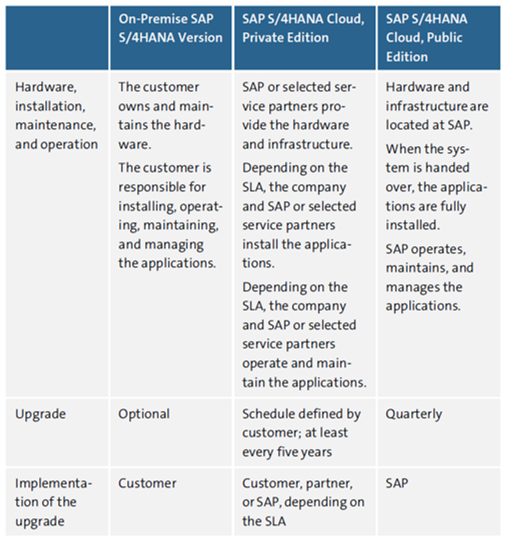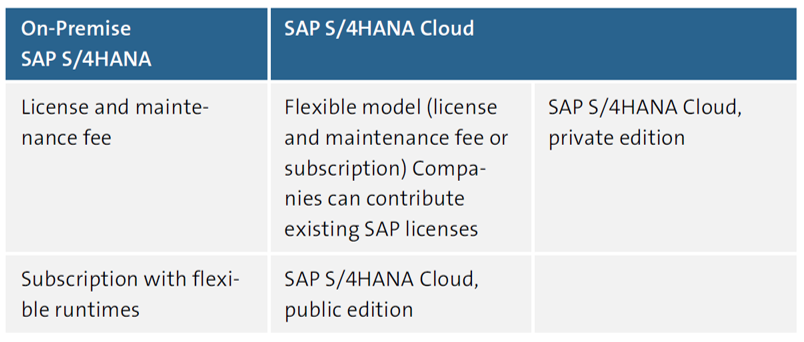This blog post describes the individual characteristics of the respective operating models of SAP S/4HANA in detail and compares how the corresponding editions of the SAP S/4HANA product family meet these criteria.
Hardware, Software, Operation, and Maintenance
The most obvious difference between the on-premise and cloud editions of SAP S/4HANA is the fact that you operate, maintain, and manage the SAP S/4HANA on-premise editions yourself, while SAP carries out these tasks in the public cloud editions. Public cloud editions are available via SaaS operating models. All SAP S/4HANA Cloud editions are operated at different data centers located in various countries and regions around the world. The table below lists the differences in detail.

For each public cloud edition, the hardware can be obtained in different packages, depending on the number of users and the required size of the SAP HANA database storage. When the cloud system is handed over, the applications are fully installed. For the public cloud editions, SAP is responsible for operating, monitoring, and maintaining the system (implementing enhancements and upgrades).
You should weigh whether you always want to have your SAP S/4HANA system up to date without having any influence on the upgrade time, or whether you want to determine the time of the upgrade yourself, but this means that innovations won’t be available to you until much later. SAP S/4HANA Cloud, public edition, is automatically updated on a quarterly basis. This means that you have innovations available immediately, but SAP doesn’t allow any exceptions when updating, so you can’t postpone the update dates. With SAP S/4HANA Cloud, private edition, you can decide when you want to upgrade the system as long as you stay within the maintenance period.
Company staffing is also a significant difference between the operating models. With the on-premise variant, the company is responsible for maintenance and operation, so it must also provide the resources for maintenance and operation. With SAP S/4HANA Cloud, private edition, SAP takes over operation and maintenance. This allows you to use the resources in your company for other tasks.
The implementation of the upgrade is intended here as just one example of how the three business models are structured. In the on-premise variant, you perform the upgrade yourself; in the public edition, this is done by SAP. In the private edition, upgrades are regulated in the SLA with SAP, so both variants are possible, even a variant where you order the upgrade from a partner company.
You can find further information on this topic in the SAP Agreements at http://s-prs.co/v581615.
User Interfaces
In all SAP S/4HANA editions, the role-based approach of SAP Fiori is the basic target user interface (UI) technology. The public cloud edition is consistently aligned with this target architecture. In individual cases, public clouds also use other web-based SAP technologies, such as Web Dynpro, in addition to SAP Fiori. In the on-premise edition and the private cloud edition, you can also use SAP GUI for Windows in addition to the web-based UI technologies (see table below). SAP GUI-based transactions that can no longer be executed in on-premise SAP S/4HANA are included in the simplification list for SAP S/4HANA. You should use the SAP Fiori launchpad as the central entry platform for end users in all SAP S/4HANA editions.

Because traditional UIs are still supported, gradual migration to SAP S/4HANA is feasible.
Functional Scope and Supported Country Versions
The SAP S/4HANA product family is based on a common program code line. Consequently, the same data models and product innovations are available. However, the editions vary significantly with regard to their functional scope, the supported country versions, and the options for customizing the business processes, for example, via add-ons.

The on-premise versions and the private cloud edition have the same business functions and support the same country versions. The complete functional ERP scope is supported in 64 countries with the standard SAP localization in 39 languages. You can use the compatibility packages for both operating models and also extend the scope with add-ons.
The functional ERP scope provided in the public cloud editions differs partially from the functional scope of the on-premise edition. For example, compatibility packages aren’t available in the public cloud edition. The supported functional scope is based on the SAP Best Practices content of the public cloud edition, which has been deployed as preconfigured. SAP S/4HANA Cloud, public edition, supports 48 countries with corresponding localization in 32 languages. The functional scope and localizations are extended continuously.
For more details on the functional scope and supported country versions, see Feature Scope Description in the SAP Help Portal (http://help.sap.com/s4hana) and in the globalization area (http://s-prs.co/ v581616)), as well as in SAP S/4HANA Cloud. The product roadmap is available at http://s-prs.co/v581617.
Options for Enhancement
You can use the following enhancements in all members of the SAP S/4HANA product family:
- Key user extensibility through integrated functions
- Side-by-side extensibility to extend the product with other products, such as SAP SuccessFactors or developments on SAP BTP
- Developer extensibility through the ABAP environment
In the on-premise variant and in the private edition, enhancements are also available to you by modifying SAP code, but in the SAP S/4HANA Cloud, private edition, with the proviso that you only add code. Keep in mind that modifications of any kind always mean increased effort for updates and upgrades. Therefore, always check whether the extension of the process can’t be realized with configurations or at least with a loosely coupled extension. Details about the extension methods can be found in the next section.
Payment Model and Runtime
Variants of SAP S/4HANA on-premise still offer the traditional license and maintenance model, whereas the public cloud editions are provided via a cloud subscription model with flexible runtimes (see next table). The actual costs for the subscription model depend on the number of users, the application scope used, and the hardware packages selected.

Model for Migration to SAP S/4HANA
For on-premise SAP S/4HANA and for SAP S/4HANA Cloud, private edition, a company has the choice of a new implementation, a system conversion, or a migration with selective data. In other words, you can convert an existing SAP ERP system into an SAP S/4HANA system, install a completely new SAP S/4HANA system, or even transfer only part of your data.
Migrating to SAP S/4HANA Cloud always entails a new installation of the system. Based on the solution packages provided, this involves implementing the business processes supported in SAP S/4HANA Cloud and transferring the necessary master and document data to the cloud system.

Editor’s note: This post has been adapted from a section of the book Migrating to SAP S/4HANA by Frank Densborn, Frank Finkbohner, Jochen Freudenberg, Martina Höft, Kim Mathäß, and Boris Rubarth.




Comments